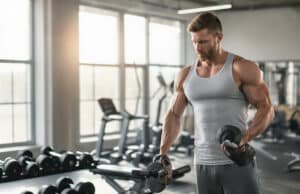If you’re aiming for a well-rounded, sculpted chest, targeting the lower chest exercises is a must. Many people focus on the upper or middle chest but forget that developing the lower part gives your chest depth and a sharp, athletic shape. For anyone training in Australia, especially at a dynamic gym like EFM Glenelg, adding specific lower chest exercises to your routine can fast-track your results. These exercises help build muscle where it matters most for that full, balanced look. Whether you want to look great at the beach or boost your pushing power for other workouts, focusing on the lower chest ensures your physique stands out. In this article, we’ll walk through 10 of the best exercises designed specifically to sculpt and strengthen your lower chest.
Why Focus on the Lower Chest Exercises?
The lower chest is key to achieving a chest that looks complete and powerful. Many people notice that their chest lacks fullness or a defined ‘shelf’ beneath the pecs this is usually because the lower chest isn’t getting enough attention. Targeting the lower chest doesn’t just boost your physique it also helps improve overall upper body strength and supports better posture. For Australians who love outdoor activities or spending time at the beach, a well-defined lower chest adds confidence and presence. Plus, stronger lower pecs support your shoulders during pressing movements, reducing injury risk. So, dedicating time to train the lower chest is a smart move that pays off both visually and functionally.
Understanding Chest Anatomy
Your chest muscle, the pectoralis major, has two primary parts: the upper and the lower fibers. The upper chest fibers run towards your collarbone, while the lower fibers attach along the sternum, extending toward the ribs. When you perform flat bench presses, you mostly target the middle chest. To specifically hit the lower chest, exercises need to involve a downward pressing angle or movements that emphasize stretching and contracting the lower fibers. Understanding this anatomy helps you pick exercises that truly activate the right part of your chest, so you don’t waste time on ineffective training. Proper technique that respects this anatomy ensures better muscle growth and overall balance.
Tips to Maximise Lower Chest Exercises Activation
To get the most out of your lower chest workouts, it’s important to use the right form and control. Exercises done on a decline bench or at a downward angle naturally focus tension on the lower chest. However, even with the correct angle, your mindset plays a huge role—concentrate on feeling the muscle work rather than just moving the weight. Avoid swinging or jerking, and use slower, controlled repetitions to enhance muscle activation. Also, incorporate a mix of free weights, cables, and bodyweight exercises for variety and to hit the muscle from different angles. Finally, don’t rush your training; patience and consistency are the secret to carving out a sculpted chest.
1. Decline Barbell Bench Press
The decline barbell bench press is a go-to move for effectively hitting the lower chest.By lying on a bench that’s angled downward, you press the barbell away from your lower chest, which places most of the tension exactly where you want it. This exercise allows for heavy loads, encouraging both strength and muscle growth. When performing the decline press, make sure your grip is slightly wider than shoulder width, and lower the bar slowly to your lower chest area for maximum stretch. Controlled movement avoids shoulder strain and helps you build a powerful, defined lower chest. For Australians used to training in well-equipped gyms like EFM Glenelg, this is a go-to exercise for solid chest development.
2. Decline Dumbbell Press
The decline dumbbell press gives you a greater range of motion than the barbell version, helping you engage the lower chest more effectively.Using dumbbells lets each arm move independently, which helps fix muscle imbalances and allows a deeper stretch during the descent. Lying on a decline bench, press the dumbbells up and together while keeping your palms facing forward. This natural movement pattern targets the lower chest fibers effectively. Because you control each weight separately, you can focus on form and muscle activation without sacrificing safety. This exercise is especially useful for those who want to build a symmetrical and well-rounded lower chest without putting too much stress on the shoulders.
3. Cable Crossover (Low to High)
Cable crossovers from a low pulley position, moving upward and inward, are fantastic for isolating the lower chest muscles. The constant tension provided by cables throughout the motion makes this exercise particularly effective for muscle shaping and definition. Stand with one foot forward for balance, and pull the cables in a wide arc, imagining you’re hugging a big tree. This action ensures the lower chest fibers are fully engaged. The cable crossover is excellent as a finishing move after heavy pressing exercises to bring out muscle detail. Plus, it allows for a controlled contraction and stretch that’s hard to achieve with free weights alone.
4. Chest Dips (Forward Lean)
Chest dips are a brilliant bodyweight exercise to strengthen the lower chest when done correctly. Leaning forward during the dip shifts emphasis from the triceps onto the lower chest. Keep your elbows slightly flared and go down slowly, feeling a deep stretch, then push back up by driving through your chest muscles. This move builds strength and muscle definition naturally, requiring no equipment other than parallel bars. If you’re comfortable, you can add weight with a dip belt for extra resistance. For gym-goers in Australia, chest dips are a functional, time-tested way to sculpt the lower chest while improving overall upper body strength.
5. Incline Push-Ups
Changing the angle of your push-ups can alter which chest muscles get the most work. Incline push-ups, where your hands are on an elevated surface, shift focus toward the lower chest. This is a perfect starting point for beginners or for those looking for a quick home workout. Elevating your hands means the lower chest takes on more load during the push. Keep your body straight, lower yourself slowly, then push up powerfully. These push-ups help build endurance and tone, and they’re gentle on the joints. The convenience and effectiveness of incline push-ups make them a popular choice for people looking to shape their lower chest without fancy equipment.
6. Seated Machine Chest Press
Seated chest press machines are great for beginners or anyone focusing on controlled, safe training. When you adjust the seat so the handles press downward, the machine targets your lower chest nicely. The guided movement ensures perfect form and reduces injury risk, making it easier to lift heavier weights without worry. For those who might be recovering from injuries or want to build a solid strength foundation, the chest press machine is invaluable. It provides consistent resistance and allows you to focus on contracting your lower pecs without balancing a barbell or dumbbells. It’s a practical, effective addition to any chest workout plan.
7. Decline Dumbbell Flyes
Decline dumbbell flyes offer a unique way to stretch and contract the lower chest muscles. Unlike pressing movements, flyes isolate the chest fibers and emphasize the stretch at the bottom of the movement. Lying on a decline bench, hold dumbbells with a slight bend in your elbows, then slowly lower your arms wide until you feel a deep stretch in your chest. Bringing the dumbbells back together squeezes the lower pecs, helping to shape and define the muscle. Because it’s a slower, focused movement, it’s perfect for refining muscle shape and improving muscle mind-connection, essential for a sculpted physique.
8. Dumbbell Pullover
The dumbbell pullover is a classic exercise that not only targets the chest but also works your lats and helps expand your rib cage. Lying flat on a bench, hold a dumbbell over your chest with both hands, then lower it behind your head while keeping your arms slightly bent. Bring it back over your chest with a slow, controlled movement.This stretch-and-contract movement engages the lower chest indirectly, improving muscle fullness and enhancing your upper body shape. It’s a great complementary exercise for those serious about developing a broad, well-rounded chest.
9. Single Arm Cross-Body Cable Press
This exercise focuses on the lower chest unilaterally, which helps correct muscle imbalances and improves control. Secure a cable at shoulder height and press the handle diagonally across your body, focusing on engaging your lower chest during the movement. This movement requires core stability and shoulder control, making it a functional and effective lower chest builder. The single-arm action allows you to concentrate on muscle contraction and technique. It’s perfect for advanced trainers who want to fine-tune their chest symmetry and add a new challenge to their workouts.
10. Landmine Press
The landmine press is a versatile movement where you press a barbell anchored at one end upwards and slightly across your body. This pressing angle hits the lower chest, shoulders, and core simultaneously. It’s easier on the joints than traditional bench presses and offers a fresh way to overload the lower pecs. Using a landmine setup adds variety to your routine and improves functional pressing strength. For Australian gym enthusiasts looking for a joint-friendly but powerful lower chest exercise, the landmine press is an excellent choice.
How Often Should You Train the Lower Chest?
To see consistent progress, training your lower chest 1 to 2 times per week is ideal. Muscles need rest days to repair and grow, so avoid training the same area on consecutive days. Combining heavier compound exercises, like decline presses, with lighter isolation work, like cable crossovers, will maximize growth and endurance. Be sure to keep your workouts balanced to prevent overtraining and reduce the risk of injury. Tracking your progress and adjusting intensity will keep your workouts effective and enjoyable. Consistency over time is what ultimately builds that sculpted, balanced chest.
Best Practices for Muscle Growth
Building muscle starts with progressive overload slowly increasing your weights or reps over time. Combine this with a protein-packed diet to help your body recover and rebuild stronger. Staying hydrated and prioritising sleep also play big roles in your results. Don’t hesitate to change up your exercises every few weeks to challenge your muscles in new ways and avoid plateaus. Remember, muscle growth is a marathon, not a sprint, so keep pushing steadily toward your goals with patience and discipline.
Conclusion
Building a sculpted lower chest requires targeted effort and smart exercise selection. Incorporating these 10 exercises into your routine will help you develop a fuller, stronger chest with impressive definition. Remember to train consistently, focus on form, and balance your workouts to maximize gains and prevent injury. Whether you’re working out at home or a gym like EFM Glenelg in Australia, these moves provide a comprehensive approach to developing your lower pecs. With dedication and proper technique, you’ll soon enjoy the confidence and strength that come with a well-defined chest. Start today and watch your physique transform.
FAQs
1. What is the best exercise for lower chest development?
The decline barbell press is often regarded as the most effective lower chest exercise due to its ability to activate lower pectoral fibres directly.
No, it’s best to train lower chest 1–2 times a week to allow proper muscle recovery and growth.
Yes, incline push-ups specifically target the lower chest and are great for beginners and home workouts.
A decline angle between 15° to 30° is optimal for targeting the lower chest.
Not necessarily. While equipment like cables and benches help, bodyweight exercises like dips and incline push-ups are highly effective too.






